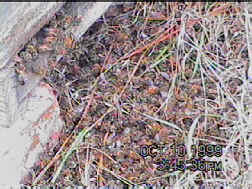
Bees, Beekeepers Clobbered by
Illegal Spraying!
Barren Spring Predicted for Farmers, Gardeners
10-10-99 Conway, SC: The environmental destruction of Hurricane Floyd has now been augmented by the destruction of pollinators, one of our most important environmental resources, during ongoing pesticide misuse by county officials. Farmers who lost their crops this year from drought and flood, will likely lose more next year from lack of pollination. Horry County has many crops that require bee pollination, including strawberries, blueberries, watermelons, cantaloupes, and cucumbers. Gardeners will find their cucumbers curled and knotty, and their melons small and tasteless from lack of bee visits to the blossoms.
Malathion is being used in a massive assault against mosquitoes. Unfortunately, when misused, malathion seems to cause more damage to bees than to mosquitoes. In areas that were sprayed yesterday, mosquitoes were still fierce, while bees were dead and dying. It is obvious that these daytime applications are not only illegal, but ineffective as well.
The malathion label prohibits application while bees are foraging in the application area, but county sprayers seem to be getting away with ignoring the label directions and spraying full-tilt while bees are out doing their work. Bees foraged today from 9:45 AM to 6:20 PM.This was determined by observations of bees carrying pollen to the hives, and/or by actual sightings of bees on the flowers. But county mosquito control personnel refuse to monitor the times that bees forage, which is necessary, if they are to comply with the law.
 |
Sunday morning, after bees began foraging, L. W. Rabon, of Aynor, SC, observed aerial applications over his home bee yard and other yards beginning at 10:50 and repeated passes occurring for about an hour. Bees had definitely begun foraging, so this was a clear violation of the malathion label. He has serious damage to his bees, with many dead and dying bees at the entrances of the hives. Beekeepers know that many of the bees never make it back to the hives, so the damage that is seen is only a part of the total. |
The hives sustaining the worst damage are the breeding stock for next year, as they are the ones with the greatest quantity of workers out in the field. Bee kills from such violations create selective breeding in favor of the weakest, poorest lines of bees.
Using honeybees for monitoring, with strict compliance with the label directions, will also protect bumblebees, solitary bees and other pollinators. Violations knock out all pollinators. Loss of pollinators not only affects famers and gardeners, but also takes away feed for wildlife, and is part of the cause for the decline of bird populations.
Dave Green, a Hemingway beekeeper whose pollination business was nearly destroyed by similar violations in mosquito spraying after Hurricane Hugo, estimates the damage to Rabon's operation to be around $10,000 by the applications Sunday morning, with damage to the farmers who rely on his bees for free or paid pollination that could well total five figures.
More violations on the same day!
Caught in the Act! 1. Caught in the Act! 2. What does a pesticide violation look like? 3. Are there blossoms? 4. Are there bees on the blossoms? 5. What is the first rule of pesticide use? 6. Who enforces pesticide laws? 7. Do the regulators have the will to enforce against this crime? 8. What about the mosquito threat? 9. How to comply? 10. How does one set up a monitor? 11. Condoned Evasion Scheme! 12. Hey, not all applications are wrong! 13. Contacts for comment or information Home
Part II: The damage: Bees, Beekeepers Clobbered! More Violations Home